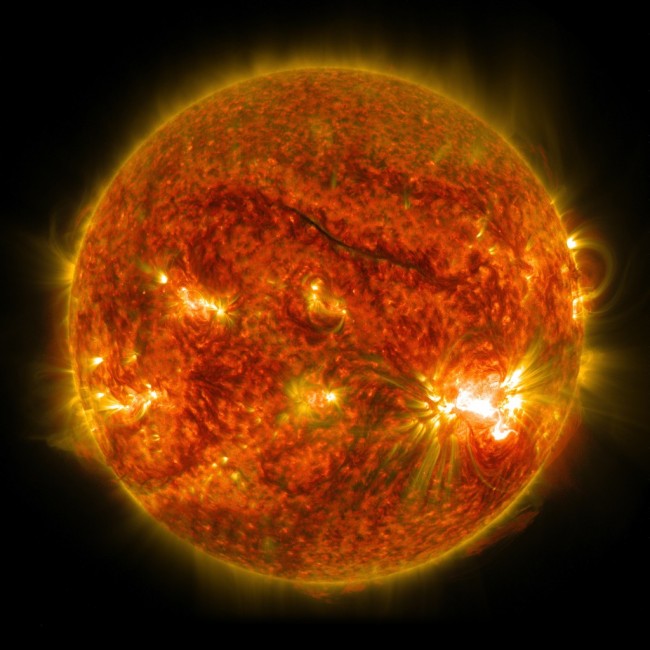Fetch The Generator: A Huge Spot On The Sun Is Acting Weird

The bright light in the lower right region of the sun shows an X-class solar flare on Oct. 26, 2014, as captured by NASA’s SDO. This was the third X-class flare in 48 hour. Image by NASA/SDO
AS I write, it’s 23 degrees Centigrade in London. On Halloween.
PBS has news:
By the time the giant spot on the sun rotated into view on October 18, it was already 80,000 miles wide, big enough to fit all of Jupiter, big enough to lay 10 Earths, side by side, across. It is the largest spot the sun has harbored in 24 years.
But while most erupting sunspots lob chunks of plasma outward in events called coronal mass ejections, this one’s keeping its plasma close to the surface.
To rewind, a sunspot is a darker, cooler area on the sun’s visible surface that stores intense magnetic energy. (Note: Cooler, in this case, means roughly 7,500 degrees Fahrenheit, down from about 10,000 degrees Fahrenheit.)
The sun is not a solid body. It’s a ball of hot, hot ionized gas called plasma that’s threaded with magnetic field, created by charged particles moving around. The sun spins faster at its equator, and the result is that some of that magnetic field drags, getting twisted and knotted up in the process. As this happens, these knots of magnetic field gain energy, pressure and buoyancy, and some of them float to the surface, and penetrate it, popping out…
Releasing this pent-up energy typically takes two forms: a solar flare or a coronal mass ejection, and this is key to what makes the behavior here unusual. A coronal mass ejection is made up of balls of gas ejected from the sun’s outer atmosphere, consisting of charged particles and magnetic field. The fastest CME’s travel up to 93 million miles a day, or millions of miles per hour. A solar flare is a burst of x-rays and energy, typically smaller and shorter-lasting than a CME, and rather than being launched out into space, it is caused by material accelerated back into the sun…
When a solar flare erupts, it lights up the side of the Earth that’s facing the flare, and heats up the Earth’s upper atmosphere, or ionosphere, which can temporarily change its properties. Solar flares pose less danger than CME’s, but they can affect short-wave radio communication used by pilots and ships, since the radio waves are bounced off the upper atmosphere.
Sunspots, first seen through a telescope by Galileo, are classified by how complex they are. Similar to a mole, a clean, round sunspot is of less interest to sun watchers.
“Imagine the doctor says you’ve got a nice little round mole,” Young said. “But when it starts to break up into pieces and change color and get jagged and complicated, that’s when you start to become concerned.”
Posted: 31st, October 2014 | In: Strange But True, Technology Comment | TrackBack | Permalink


